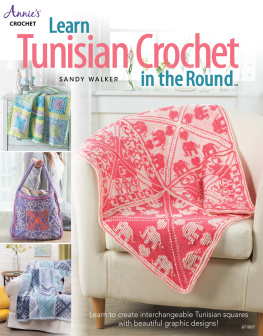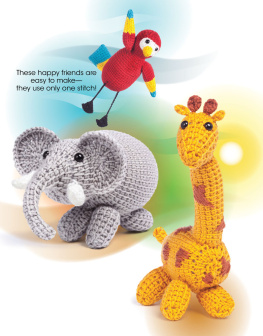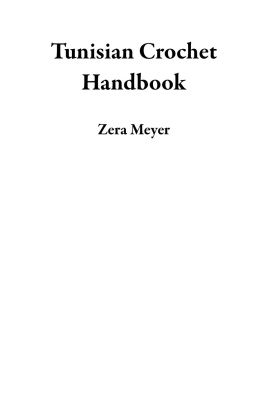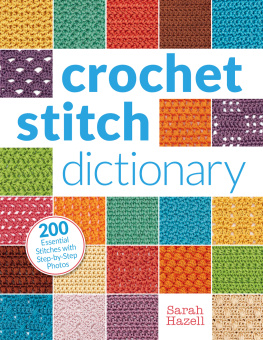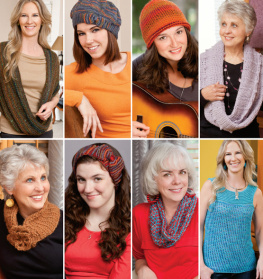Table of Contents
Guide
Table of Contents
General Information
My goal is to teach you how to complete some amazing projects using Tunisian in the Round (TITR). You will learn to stitch square blocks with beautiful graphic designs, make strategic color changes and utilize my favorite new product: self-striping yarn. I am so excited to share this technique and debunk the belief that Tunisian crochet is nothing more than one stitch that curls.
Ive been playing with TITR for the past few years, stitched more than 100 different original designs, and spent extensive time determining how to best document the technique and patterns. The first TITR crochet along (CAL), Every Penny Counts debuted in October 2019, and garnered rave reviews from participants. The collection of patterns has grown steadily and hundreds of our fellow fiber artists have successfully completed projects.
The patterns are geared to competent beginners, meaning that you are familiar with the techniques of Tunisian crochet, including forward and return passes, basic stitches and have consistent tension.
The patterns are presented in uncomplicated chart form and have been very well received by my students. Trust me (and hundreds of others), they are easy to follow, provide great visual cues on the stitch pattern shapes, and include stitch and round counts.
There are 15 different stitch blocks with the same number of rounds used for two blankets and totes. When you are comfortable with the technique, I encourage you to play. Blankets can easily be made larger or smaller by altering the number of blocks. You can choose to repeat only your favorite blocks for an entire project, alter color choices, use self-striping yarns, etc. I love seeing all of the variations in my Stitch It Your Way, One Pattern, Infinite Possibilities designs.
Lets talk about TITR, another kind of hook up
TITR techniques using double-ended hooks are an absolute game changer. It is the best method in crochet (or knitting) for lettering, graphics and mosaic designs with no yarn stranding or carries. Two balls of yarn are used, one for the forward pass and one for the return pass. Using a different color for each pass, designs are created by using stitches that either hide or show the return pass color. Using the same color for both passes offers a more subtle texture and is a perfect platform for adding cables.
TITR is most often used to create seamless, tubular projects such as hats and cowls. TITR used for flat pieces such as squares and other geometric shapes is only slightly more challenging, far more versatile, and creates amazing designs with texture and visual impact.
I placed first in the Tunisian design category at the 2019 Crochet Guild of America (CGOA) conference with Pennys Puzzle. All geometric shapes, squares, octagons and triangles were created using TITR and included solid-color cabled octagons along with two-color graphic shapes. I teach locally and, in August 2019, I taught on a Crafty Adventures South Pacific cruise out of Sydney, Australia.
My adventures in crochet and obsession with Tunisian crochet
My mom, Penny, was a master fiber artist and could knit and crochet with the speed and precision of a finely tuned machine. I was already a knitter and took up crochet at 17, made a mini business of selling tote bags to friends, taught crochet, and moved on to making blankets as gifts. My mother crocheted my spectacular wedding dress in 1976 and I made matching shawls for the bridesmaids. My patterns are all part of The Penny Collection, and I am grateful to have had such an amazingly talented and patient teacher. I can still hear her saying, Use the hook, the hook is the tool.
I discovered Tunisian crochet in the 1970s, and it became my preferred technique for blankets. I made a few modifications to patterns, adding texture with bobbles and a few minor stitch variations. In 2016, I participated in my first few CALs, discovered the beauty and versatility of post stitches, and adapted them to Tunisian. My first original design, aptly named, was The Penny Drops. It became a well-received CAL and the first piece of The Penny Collection.
Tunisian is the most underrated crochet technique. Tunisian crochet results in perfectly defined stitches on all sides of a piece with clearly visible edge stitches, making joining, assembly and borders simple. Easy color changes and stitch variations result in heirloom quality pieces of heART that garner great reviews from hookers who never liked Tunisian crochet.
I love the fabric-like texture of Tunisian stitches, such as houndstooth, tweeds and herringbone. They remind me of my quilting adventures and resulted in the Pennywise, Halfpenny and numerous other blanket designs. A 2017 trip to Ireland and visit to the Blarney Woolen Mills resulted in my never-ending obsession with cables on Tunisian crochet. Pennys Ode to Ireland uses classic knitted cable designs, integrated and not overlayed, using Tunisian crochet and was my first I cant believe it is not knitted project. A visit to Scotland and the Outer Hebrides sparked an interest in tartans and plaids. I earned second place in the 2018 CGOA design competition with Halfpenny Hybrid, a combination of fabric-like and cable stitch patterns.
TITR has kept me creatively challenged for the past few years, and I spend hours as both the teacher and often the student learning the best approach, how to avoid pitfalls, and best of all, discovering something new.
I have a small Facebook group, Walker Hollow Designs, with a growing group of talented fiber artists who have completed many of my designs and earned their PhD in Tunisian crochet. 
Tunisian Crochet Hooks
Tunisian in the round (TITR) projects use double-ended hooks, similar to circular knitting needles.
I use two different-size hooks connected with a cable for all of my TITR projects; the larger size for the forward pass, and smaller for the return pass.
This corrects for tension differences on the passes and eliminates the need for two hooks of the same size. The reverse side of the project is neater looking with tighter looking loops.
Recommended hook sizes
With medium (worsted) weight #4 yarn: Forward pass L/11/8mm; return pass K/10/6.5mm
With light (DK) weight #3 yarn: Forward pass J/10/6mm; return pass I/9/5.5mm
Cable length: 16 inches or longer for a large project.
Interchangeable hooks
Hooks are available in sets that include cables and can also be purchased as separate hooks and cables in the sizes and lengths you need. A selection of cable lengths is great for larger one-piece projects.
A cabled hook with a secure end stopper can be used for regular Tunisian projects that require a large number of stitches.
There are many reviews of interchangeable hooks online and it is a personal preference which one you choose.
My current favorites are Clover Takumi Bamboo. The hooks are longer and I can comfortably crochet for hours. For hook sizes larger than L/11/8mm, I use Denise Interchangeables.
Tunisian Abbreviations
bo: bind off
eTrs: extended Tunisian reverse stitch
FP: forward pass
RP: return pass
Tdi: Tunisian double increase: Insert hook knitwise in indicated stitch, yarn over and pull up a loop; yarn over

